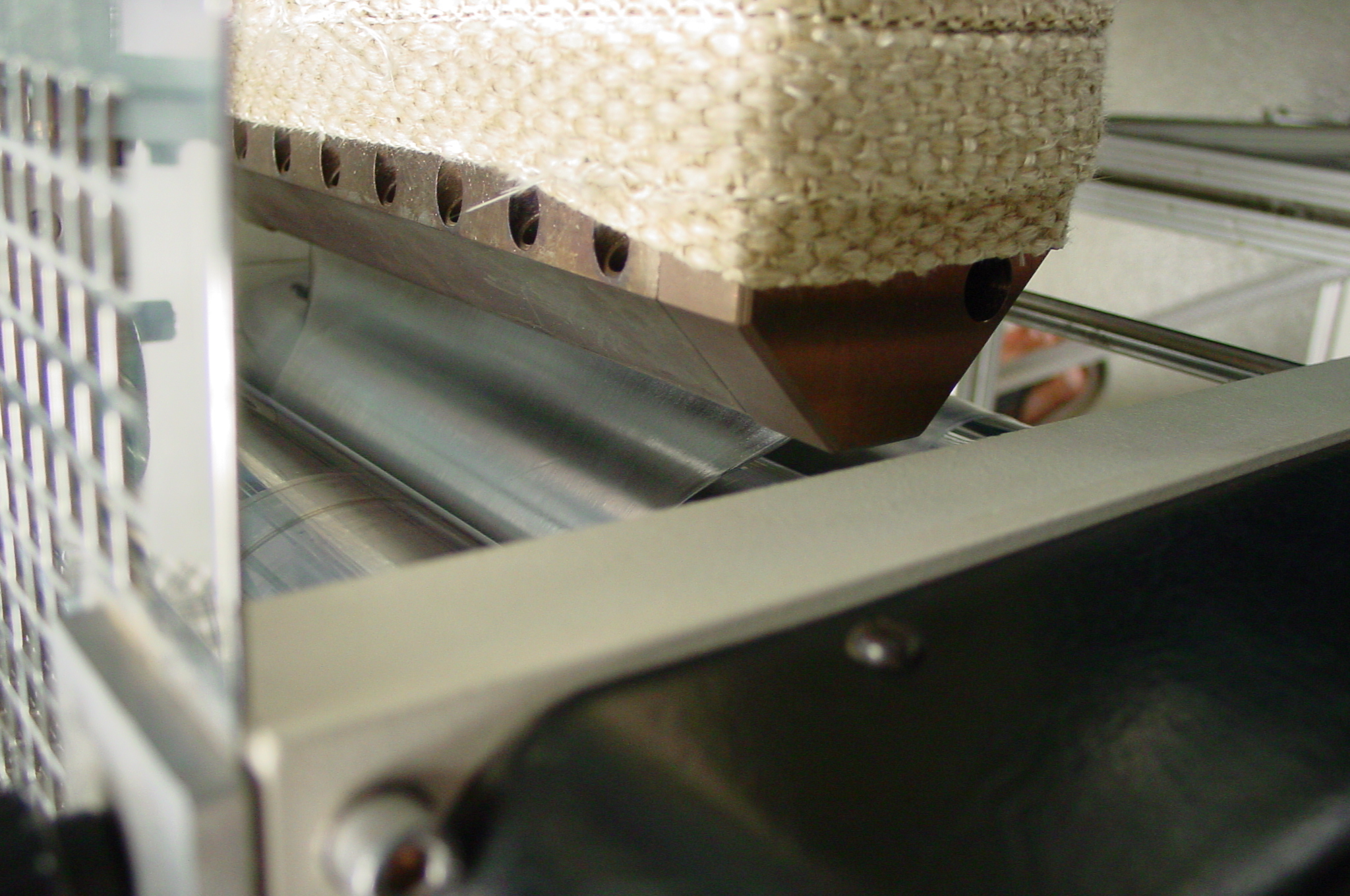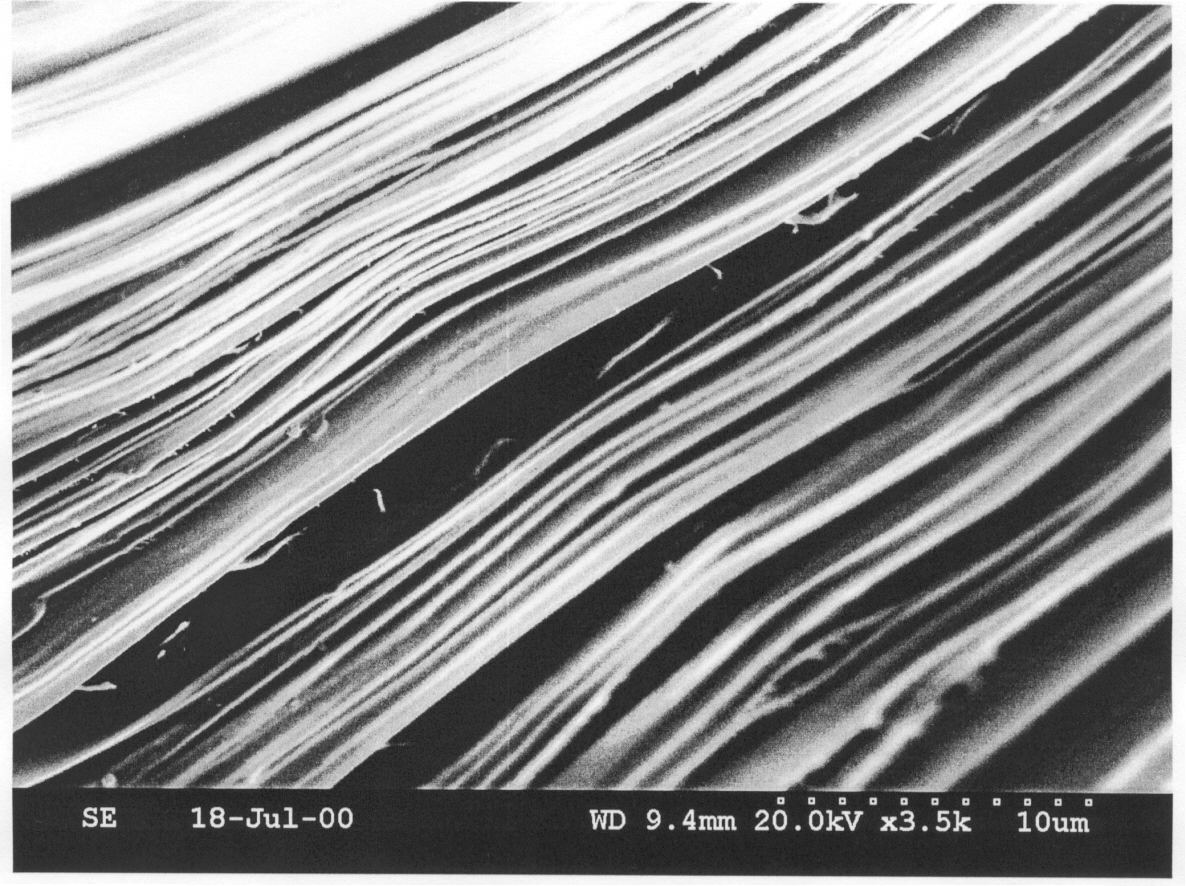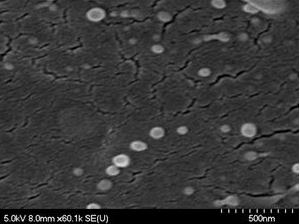|
|
College of Engineering & Science |
|
|
|
College of Engineering & Science |
|
Current Highlights

|
Smart blender in action!...A smart blender can be configured with a variety of dies to give extruded plastics with many types of morphologies or structural arrangements among solid additives in a desired net shape (i.e., film, pipe, tubing, sheet). In the photograph, a prototype smart blender is fitted with a film die where film is shown contacting a chill roll prior to winding. The film consists of two common thermoplastics arranged to impart property enhancement via morphology optimization. Structure-property optimization can be readily done since morphology can be controllably developed with smart blenders. For information on smart blending concepts, please see the tutorial. |

|
Controllable formation of submicron multiple layers: A new chaotic advection-based process has been developed where plastic extrusions of various forms (e.g, film, pipe, sheet, etc.) can be produced with a variety of blend morphologies in continuous lengths. Essentially, morphology is selectable on-line by control of chaotic advection and other parameters such that no equipment modifications are required. In the micrograph, an example is shown of a novel blend that contains thousands of internal sub-micron layers (Zumbrunnen, D. A. and Inamdar, S., 'Novel Sub-Micron Highly Multi-layered Films Formed by Continuous Flow Chaotic Mixing,' Chemical Engineering Science, Vol. 56, pp. 3893-3897, 2001). The thicknesses and number of layers are selectable via control features in smart blending devices. Fibrous, interpenetrating, platelet, percolating, and droplet morphologies are examples of other blend morphologies that have been formed. Various morphologies are obtained via sequential morphology transitions beginning with the layered morphology. Some morphology examples are given at the top of this page. (TOP) For more recent examples, please see our publications. |

|
Formation of very
small droplets and other nano-scale shapes
in polymer blends and viscous liquids:
A frequent goal is to produce very
small droplets. Intensive mixing is commonly
used in order to disperse and break up a viscous
minor component. However, with smart blending
methods, the minor component is converted initially
to very thin, numerous layers in the melt by chaotic
advection. The layers break up to give droplets such
as the 50 nanometer droplets shown in the micrograph
to the left. Droplet size is correlated to the parent
layer thickness so extremely small diameter droplets
can be formed in polymer combinations where very
thin layers can be created. Manufacturing processes that
make use of this approach can have much reduced energy expenditures
in comparison to current processing methods, such as
compounding in a twin screw extruder. Also, a low shear
condition allows use of melts that are prone to degradation.
Methods can also be used to form other nano-scale structures
in melts among solid additives or melt components for retention
in extrusions of desired forms (e.g., sheet, film, pipe).
For more information, see: D. A.Zumbrunnen, S. Inamdar,
O. Kwon, and P. Verma, "Chaotic Advection as a Means
to Develop Nanoscale Structures in Viscous Melts,"
Nano Letters, Vol. 2, pp. 1143-1148,
2002. |

|
Low permeation (high
barrier) plastics: Kwon, O. and
Zumbrunnen, D. A., "Production of Barrier Films
by Chaotic Mixing of Plastics,"
Polymer Engineering
& Science, Vol. 43, pp. 1443-1459, 2003.
Abstract:
Recent studies have demonstrated that
highly multilayered blend morphologies can
be formed by chaotic mixing and captured
within extrusions of various forms. The
number and thickness of internal layers prior
to layer breakup and the extent of breakup are
controllable via specification of process variables.
A variety of derivative morphologies can thereby
be obtained. Although methods can be applicable to
other blends, the relation of oxygen permeability
to various morphologies was specifically investigated
in this study for extruded films without stretching
consisting of ethylene vinyl alcohol copolymer, low density
polyethylene and maleic anhydride modified polyethylene
as a compatibilizing agent. Optimal barrier properties
were obtained in a novel single phase continuous and
mechanically interlocked morphology that was an outcome
of stretching and folding characterizing chaotic mixing.
Barrier properties were similar to those obtainable
in co-extruded films due the presence of abundant platelets
across the film thickness and crystallinity increases
caused by barrier phase refinement. (In the micrograph, an extruded film was immersed
in liquid nitrogen and fractured to reveal thin platelets
that were formed. Entire
films contained numerous platelets and other high surface
area shapes such as ribbons that were volumetrically
distributed throughout the film thickness. Because
finer internal barrier structures can be formed
in them, the potential is to produce barrier films that
exceed the performance of co-extruded films.)
|